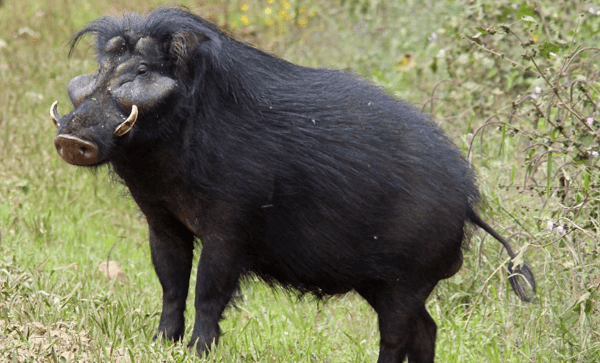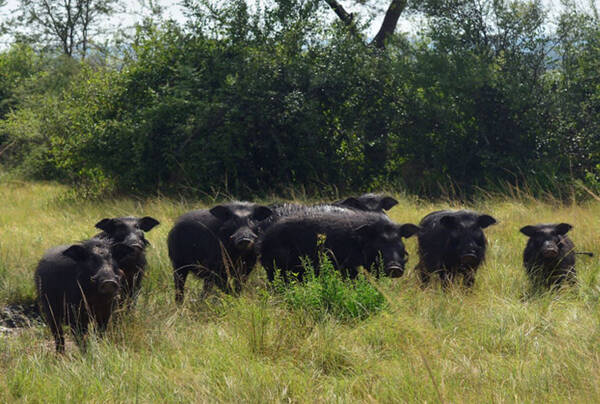Hylochoerus meinertzhageni
IUCN
LCBasic Information
Scientific classification
- name:Hylochoerus meinertzhageni
- Scientific Name:Hylochoerus meinertzhageni,Forest Hog
- Outline:Ungulata
- Family:Artiodactyla Suidae Dalinsu
Vital signs
- length:130-210cm
- Weight:180-275kg
- lifetime:About 12 years
Feature
Males have bare, swollen pads of skin called calluses near the eyes and scent glands on the cheek pads.
Distribution and Habitat
Origin: Cameroon, Central African Republic, Congo, Democratic Republic of Congo, Cote d'Ivoire, Ethiopia, Gabon, Ghana, Guinea, Kenya, Liberia, Nigeria, Sierra Leone, Sudan and Uganda.
Possibly extinct: Rwanda.
Extinct: Equatorial Guinea.
Found in Africa, the Great Forest Pig is found mainly in the equatorial forests and grasslands west of the western Rift Valley. There are some scattered small populations northeast of Lake Victoria, and larger numbers are found from Nigeria to Senegal. There are three recognized subspecies, each with a different range. The Western Great Forest Pig (H. m. ivoriensis) lives in the area near the Ivory Coast; the Central African Great Forest Pig (H. m. rimator) lives in two areas near the central equatorial west and the central equatorial west, and coexists with the eastern equatorial area; the Nominate Great Forest Pig (H. m. meinertzhageni) lives in eastern Africa.
The Great Forest Pig prefers to live in dense bushland. It is found in v
Appearance
The Dalin pig is about 190 cm long, about 1 meter tall, and weighs 180-275 kg. The head is broad, and the male has exposed, swollen pads of skin, or calluses, near the eyes. Both sexes have small, straight teeth that flare outwards and are up to 30 cm long, with conspicuous and sharp tusks. There are large, pointed ears and a bristle on the body and tail. The fur is slate gray in color, with some lighter hair on the cheeks. Male pigs have scent glands on their cheek pads, which are foreskin-covered scent glands. Females are slightly smaller than males and have 4 udders.
Details
The Forest Hog (Hylochoerus meinertzhageni), also known as the Forest Hog in English, has three subspecies and is the largest pig. The species name "meinertzhageni" of the Forest Hog is derived from the surname of Colonel Richard Meinertzhagen, a British officer and zoologist. He was the first to send specimens of the African Forest Hog back to the UK, which earned him a series of international reputations.

The Great Forest Pig is diurnal and can be found in dense forests along the equator. The daily range of activity is generally 8-12 square kilometers, and the maximum daily activity time is 10 hours. Most of the time, it is active in familiar areas. It will defecate at a fixed location in the center of the territory, and the height of the feces can reach 1.1 meters. Each group of Great Forest Pigs has a territory of about 10 square kilometers. When there is a conflict with other groups of Great Forest Pigs, the boar is responsible for guarding the group. When boars fight, they attack each other from a distance of 20-30 meters, and the winner celebrates by grinding his teeth and urinating to mark territory. The loser runs away with his tail up. Some suffer skull fractures or are killed.
The Great Forest Pig is a timid animal that lives in areas with low population density and is therefore not well known. They are nocturnal animals and live in groups of 6-14 pigs, with a 1:2 ratio of males to females, led by males. Sub-adult males form bachelor groups. In areas where they are not hunted, the Great Forest Pig tends to be more active, and they usually move around in the open air during a stable feeding period of up to four hours between dusk and midnight. The range includes foraging areas, sleeping areas, water holes, walls, rubbing places, toilets and mineral licks, which are connected by paths in the bush. This wild boar scrapes soil from logs or tree roots to make a bed. They do not tolerate other animals entering their territory, and they engage in two forms of fighting: pushing each other with their muzzles, testing their weight, or butting their foreheads, which often results in skull fractures.
The Great Forest Pig is a herbivore, eating mainly plants but sometimes carrion. The Great Forest Pig cannot use its tusks to dig for roots and minerals as well as other pigs. So they mainly eat grass, sedges, and forage. Sometimes, these pigs will also devour carrion or bird eggs.

In some areas of the Congo Basin, hunters generally avoid hunting the big forest pig because the meat of the big forest pig has an unpleasant and strange taste, but this is by no means a universal aversion. The big forest pig is sometimes caught in snares, and the meat is eaten to conceal its origin and sent to urban markets. Despite its large size, the meat of the Great Bush Pig is rarely seen in bushmeat markets, but in some areas where its density remains high, the species is considered to be at risk of being overhunted in the illegal bushmeat trade. It was upgraded from partially protected to fully protected in 2011 (PALF 2016). Significant commercial hunting of the species is concentrated in the Central African Republic and Ethiopia, but the impact on the species' population is unclear. Hunting concessions are issued in Cameroon, the Central African Republic, and Ethiopia where the species is abundant.
The Great Forest Pig occurs in some major protected areas, including: Nité National Park (Guinée), Sapo National Park (Liberia), Taï National Park (Côte d'Ivoire), Biya National Park (Ghana), Minkebe National Park (Gabon), Odzala National Park (Republic of Congo), the Tri-National Complex of Protected Areas (Central African Republic, Congo, Cameroon): Bili-Uere Hunting Reserve, Okapi Faunal Reserve, Garamba National Park, Maiko National Park, Virunga National Park and Kahuzi-Biega National Park (DRC), Rwenzori National Park, Kibale National Park and Queen Elizabeth National Park (Uganda), Aberdares National Park, Mount Kenya National Park and Maasai Mara National Park (Kenya), Bale Mountains National Park (Ethiopia).
Listed in the IUCN Red List of Threatened Species in 2016 ver 3.1 - Least Concern (LC).
Protect wild animals and eliminate game.
Maintaining ecological balance is everyone's responsibility!








